Best pregnancy exercises: a 5-move workout you can do at home
It's essential to keep moving when you're expecting - so give our rundown of the best pregnancy exercises a go
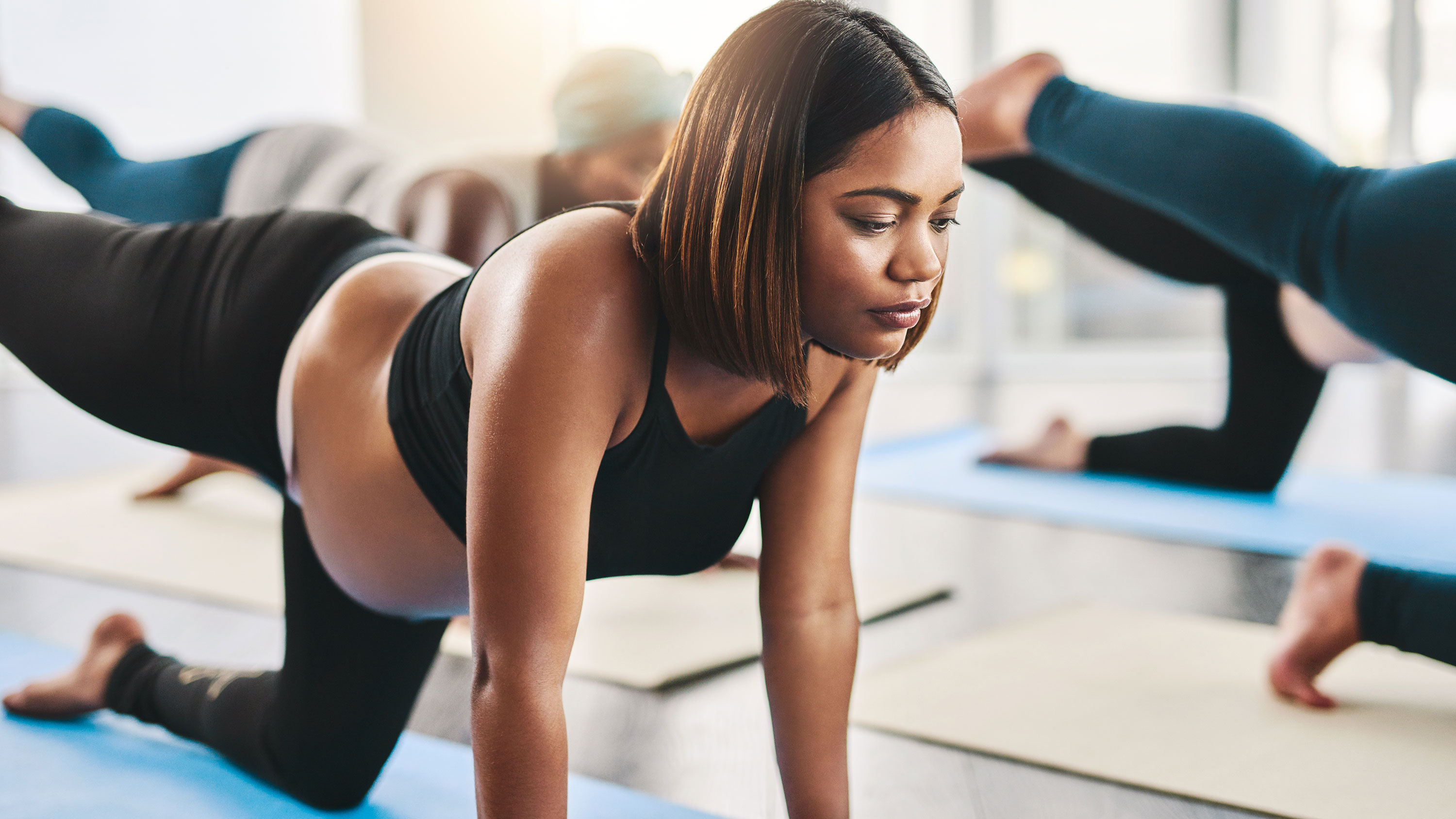

Keeping active during the prenatal period with some pregnancy exercises is recommended as a great way to enjoy a healthy pregnancy.
The positive impact for both mother and baby are vast, with the benefits not only aiding physical results, but also assisting with positive mental wellbeing and an efficient recovery postpartum.
However, pregnancy brings with it many physical changes, and as the trimesters progress it’s important to be aware of how you can modify your exercise programme accordingly.
So how should we adapt our exercise during the trimesters and which exercises are the best to perform at home? We examine all of this and more below. But first, an important reminder: always ensure you have been cleared for exercise by a medical professional before beginning any workout.
- Best adjustable dumbbells: the space-saving way to lift weights at home
- Best workout equipment for home: the best multi-gym, treadmill and more
How prenatal hormones effect your pregnancy exercise program
Before beginning pregnancy exercises, it’s important to understand how pregnancy hormones effect us physically and why it's key to consider them when planning a workout.
The hormone Relaxin is produced around two weeks after conception and continues to be present in the body until five months postpartum - and longer for breastfeeding women. The primary function of Relaxin is to loosen the ligaments in and around the Pelvis in preparation for labour, however the effects of Relaxin are not isolated to one area ,therefore the stability of all joints throughout the body become compromised.
When exercising during pregnancy, we must therefore make sure to work within a comfortable range of movement, to avoid over stretching or overloading any joints which could result in injury.
Start your week with achievable workout ideas, health tips and wellbeing advice in your inbox.
Another prenatal hormone to be aware of is human chorionic gonadotropin (hCG). This is the hormone detected by most pregnancy tests. It increases at a rapid rate in early pregnancy, often causing women to suffer with morning sickness and fatigue. If you feel unable to maintain a regular active lifestyle during this time, it is important to listen to your body and rest when necessary.
5 best at-home pregnancy exercises
- Step ups
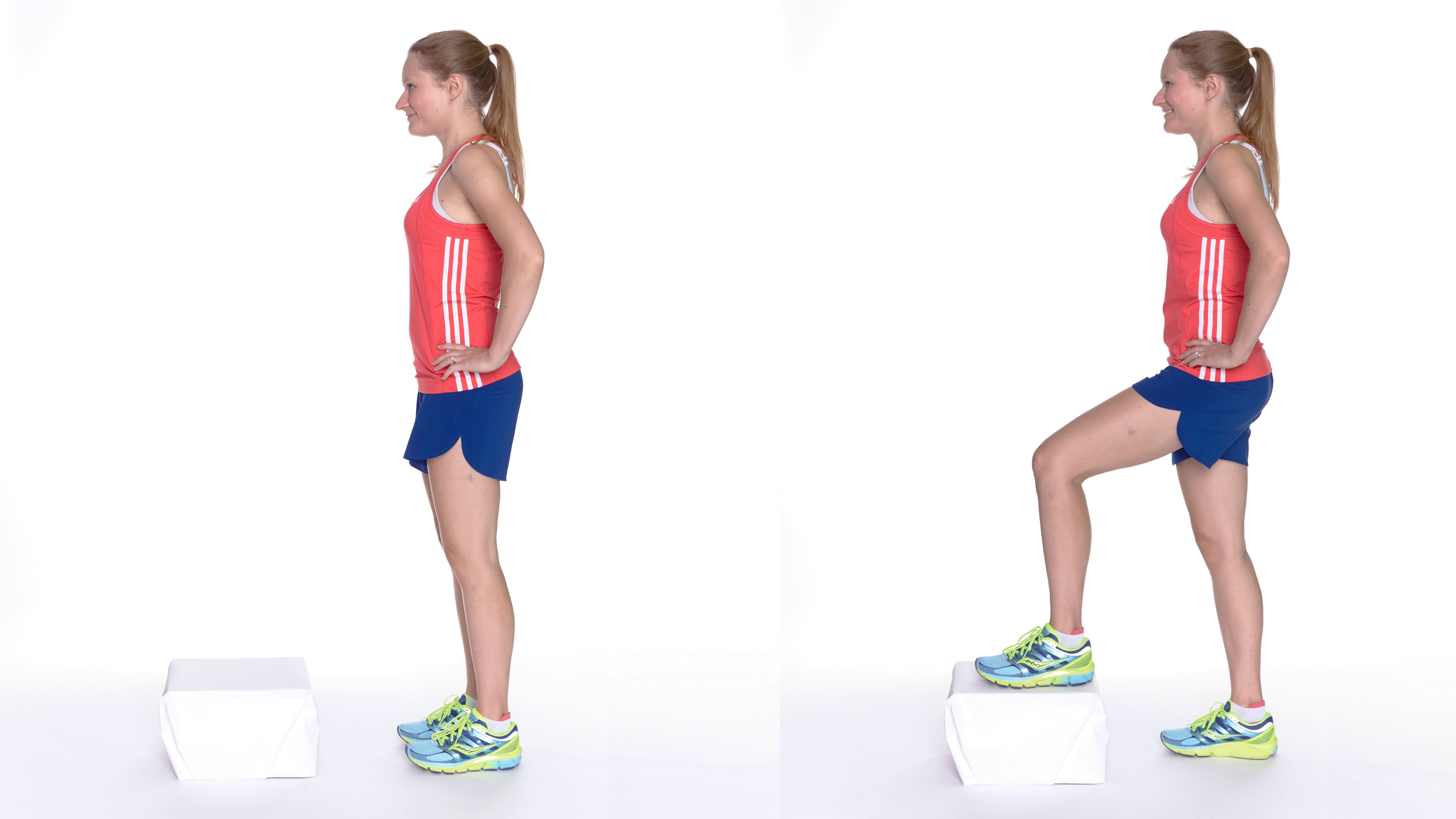
A great way to boost your heart rate whilst keeping impact to a minimum. You can increase the intensity of step ups by either increasing the speed of the movement or choosing a higher platform ( within reason). Please make sure you perform this exercise on a stable and flat surface, placing your foot firmly onto the level before pushing up to the top platform.
- Stand in front of the platform, with your feet hip width apart.
- Place right foot on top of the platform with your knee being positioned at a 90 degree angle. Step up onto the platform pushing your weight through your right heel, followed by left foot.
- Lower yourself back to the starting position by stepping down onto right foot first, followed by left. Repeat 10 times, then begin with a left foot leading.
- Tricep dips

An upper body exercises working your triceps. This can be performed with bent knees or straight legs. By straightening the legs the intensity of this exercise is increased.
- Sit on a chair or bench and place both hands on the edge with your fingers over the front of the surface.
- Walk your feet forward until your bottom lifts off the seat and slightly in front of the surface. Feel the weight of your body mainly on your straight arms.
- Now begin to bend your elbows and push them back towards the chair.Push through your palms to return back to straight arms position, working against the weight of your body. Repeat 10-12 times before walking your feet back so that you return to a seated potion.
Like this move? Discover the best workout for arms and how to lose weight on your arms
- Glute kick-backs
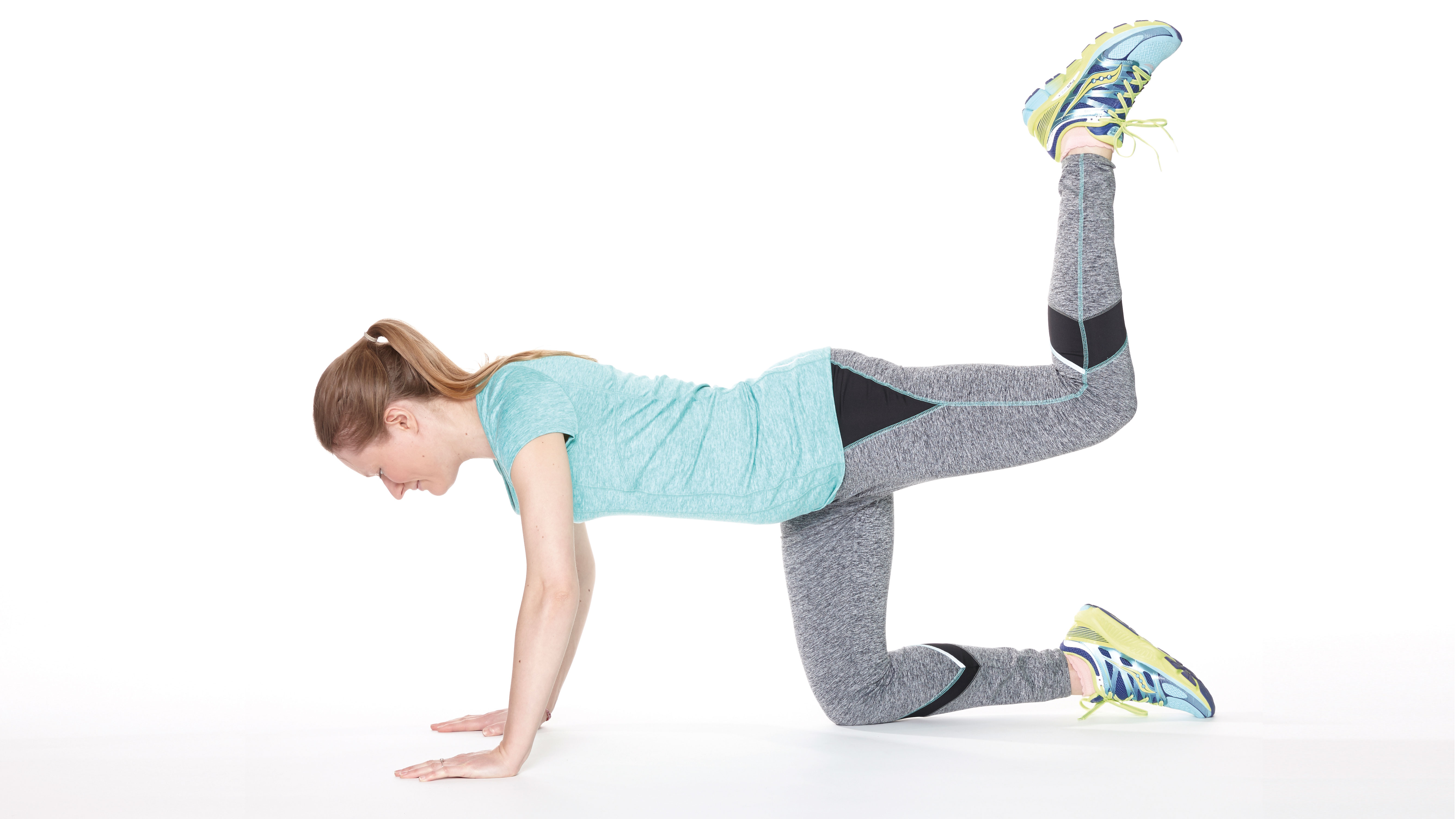
These target the Piriformis, a deep glute muscles. This exercise can be performed in the four-point kneeling position on hands and knees.
- Position yourself in a kneeling position on all fours, with your knees and hands hip and shoulder width apart. Your head is aligned with your spine. Begin by lifting one leg up behind you at a 90 degree angle and with a 90 degree bend at your knee.
- Without tilting your hips, push your leg up towards the ceiling keeping the foot flexed. Imagine your heel pushing towards the sky. Feel your buttocks muscles on that side tightening whilst holding this position for a short while, 2-3 seconds.
- Return to the starting position and immediately repeat on the same leg for 20-30 seconds. Return to the box position on all fours and repeat with the opposite leg. Be aware throughout of maintaining optimum pelvic stability.
- Kneeling Superman
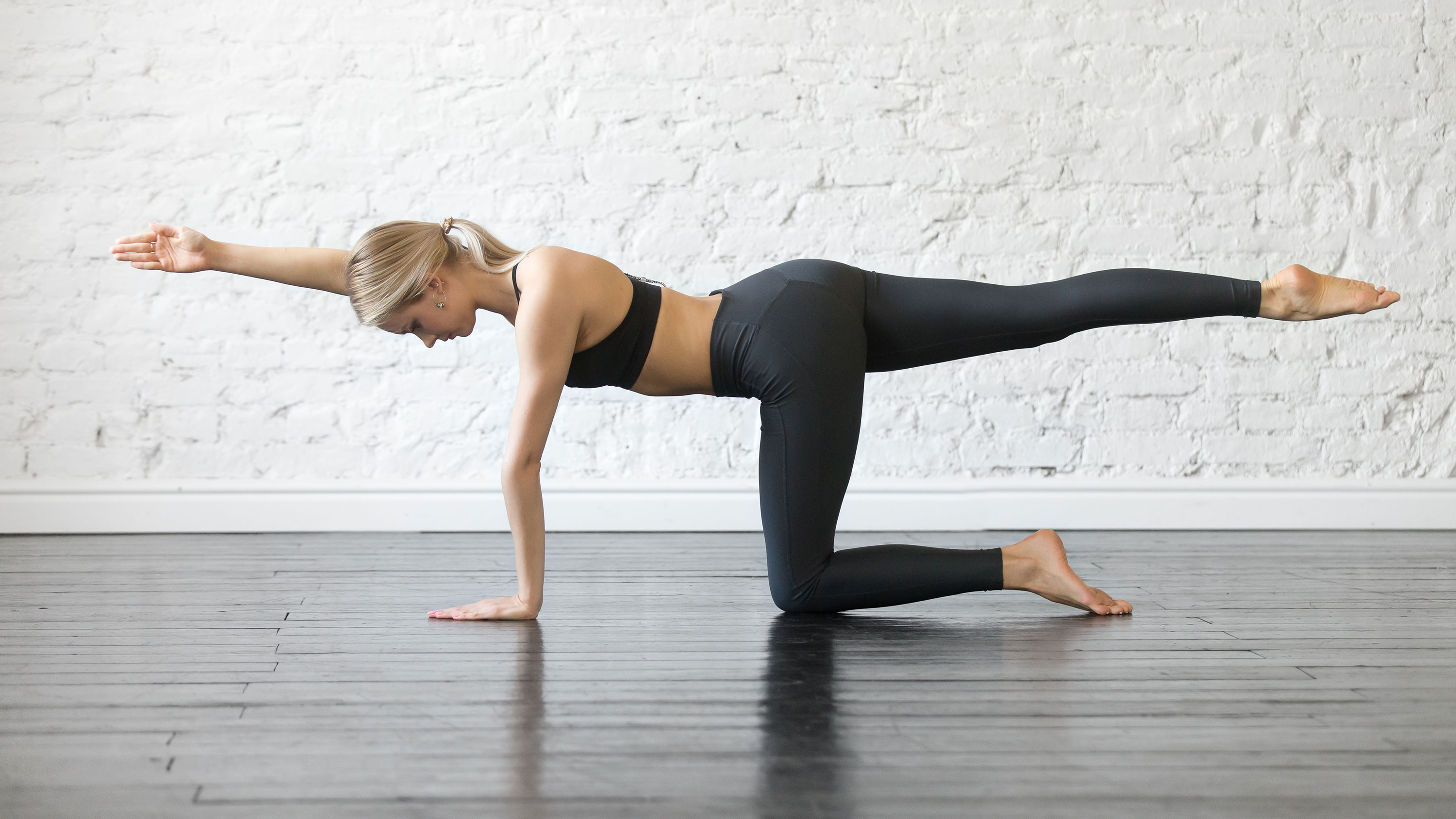
The Superman is a great exercise to work your core during pregnancy. This should be performed slowly and with good alignment, keeping your neck in line with your spine all the way to your tailbone. It’s important to not left the back leg too high as this may cause lordosis, arching of the lower back. Extend this leg out behind you whilst keeping your neck, spine and tailbone in alignment.
- Position yourself on hands and knees in the box position, ensuring your knees are hip width and your hands shoulder width apart.
- Begin by simultaneously lifting your right leg straight behind you whilst lifting your left arm straight out in front of you. Aim to find balance and stability in this position, keeping hips in good alignment without tilting the pelvis.
- Return to starting position and repeat with left leg and right arm.
- Marching knee lift with arm combo
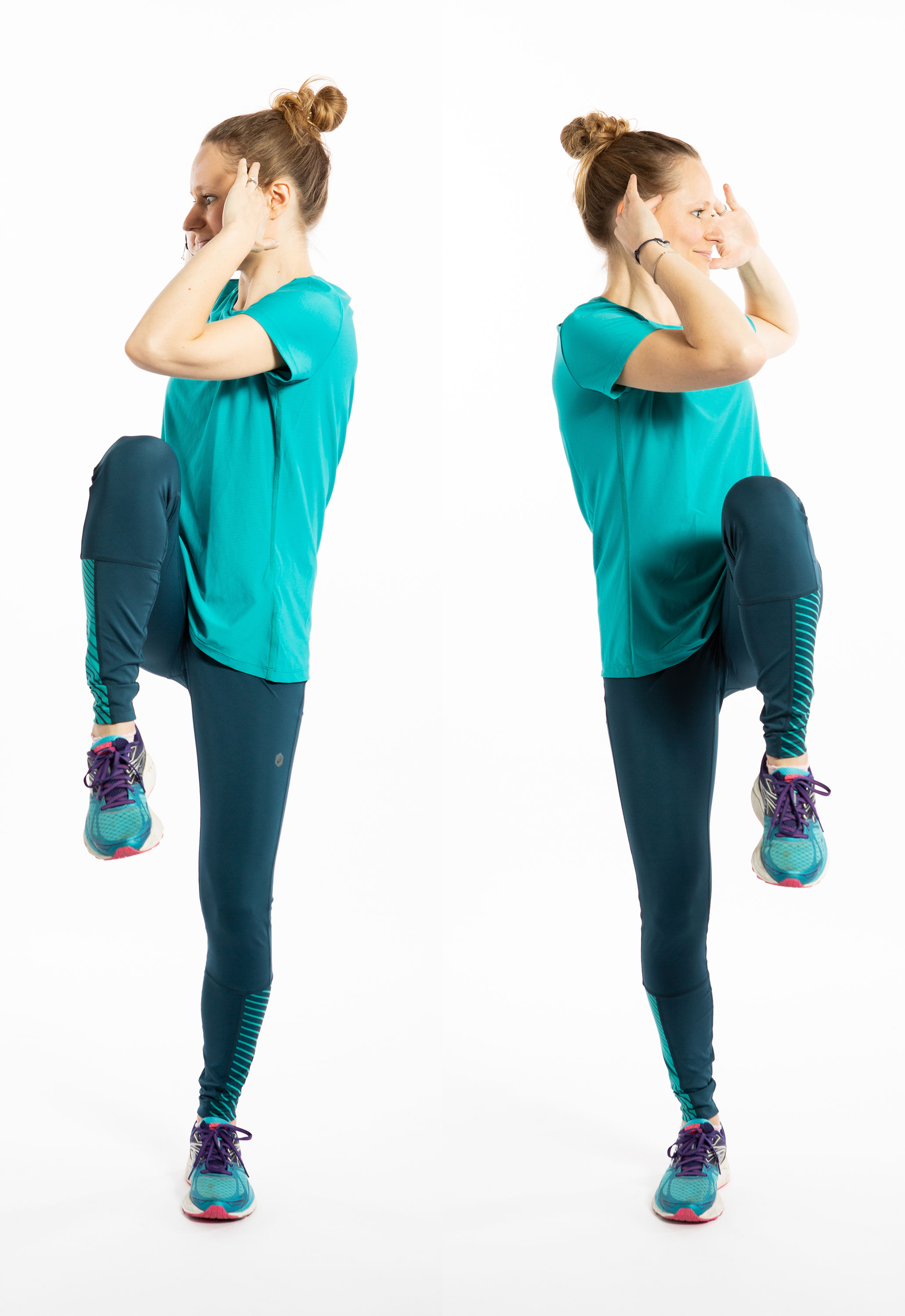
A cardiovascular exercise whilst keeping impact to a minimum this exercise safely challenges the core by combining a leg lift and bringing elbow to knee.
- Stand with feet hip-width apart. Begin by lifting the right knee in front of your body whilst simultaneously drawing your left elbow towards your knee. For women in the later stages of pregnancy, you may need to angle your leg slightly to the side of your bump as your knee lifts up.
- Return to starting position and repeat the same exercise with your left leg and right elbow.
Exercise in pregnancy: modifications to make depending on your trimester
As the trimesters progress and the uterus expands, further modifications need to be taken into consideration.
- Exercising in your first trimester
According to the American College of Obstetricians and Gynaecologists, if you were very active before pregnancy, you can keep doing the same workouts with your obstetrician’s approval.
It’s advised that pregnant women get approximately 150 minutes of moderate-intensity aerobic activity every week, with a minimum of three lots of 15-minute sessions for those how led a sedentary lifestyle pre-pregnancy.
However, statistics and numbers can only take us so far. Every woman experiences pregnancy differently and it’s important to work within parameters that feel comfortable to you.
It is also important that from the first trimester onwards that pregnant women stay well hydrated, in particular when engaging in exercise. Sipping water frequently is recommended as opposed to overloading on fluids immediately prior to or after a workout.
- Exercising in your second trimester
As pregnancy progresses, working to a percentage in terms of exertion is a good way to monitor your intensity. According to a study released by the United States National Library of Medicine, prenatal exercise intensity should not exceed a range of approximately 60-70% maximum exertion.
Using percentages allows each women to monitor her own unique progress, as 70% for one person may differ greatly to that of their neighbour. It is also true that a persons exertion percentage changes day to day, depending on mood and current physical state etc, therefore it’s important to remain aware of how you are feeling in the moment.
For those with an interest in lifting weights, it is safe to lift overhead during pregnancy. However, this should only be for a short period of time and assuming you have experience with lifting weights pre-pregnancy.
Be careful not to lift too heavy to avoid overloading the core and compromising technique. If you find you are arching too much in the lower back, clenching your jaw or curling your toes in order to perform a movement, it may be a sign that the exercise is too challenging at this time.
- Exercising in your third trimester
During the third trimester the focus shifts to labour preparation exercises. By working on controlled breathing techniques to activate the core, we can strengthening key stabilisers that may be useful during labour.
It’s also important to remember to practice releasing and relaxing the pelvic floor, as an over active pelvic floor can create dysfunction in the core.
Learning to relax in this area is key to assist an efficient labour and allow baby to descend through the birth canal.
All exercises should be low-no impact and some positions may need to be avoided. For example the four point kneeling position may become uncomfortable for anyone with a larger bump, such as with a multiple-birth pregnancy.
Shakira Akabusi is founder of StrongLikeMum, an advanced pre and postnatal practitioner, speaker, writer and mum of four - including newborn twins. Having trained clients for over 10 years, Shakira is passionate about encouraging positive physical and mental wellbeing. Combining her expertise as a pre and postnatal specialist with her experience as a mum allows Shakira to offer a unique insight into maintaining a healthy lifestyle as a mother. Shakira promotes whole body health, and is particularly passionate about highlighting the connection between physical and mental wellbeing. Having launched her StrongLikeMum podcast earlier this year, Shakira is excited to release the full StrongLikeMum Method shortly.
